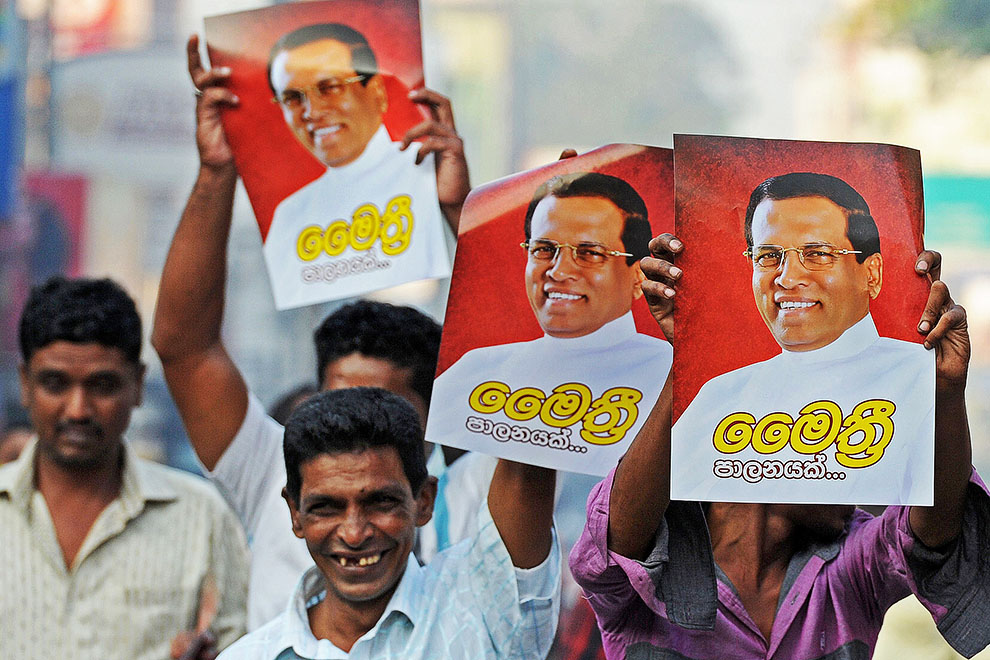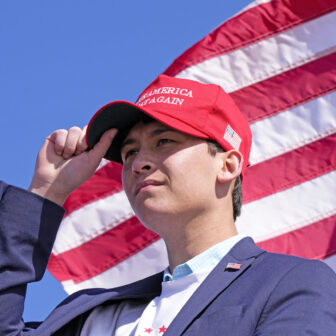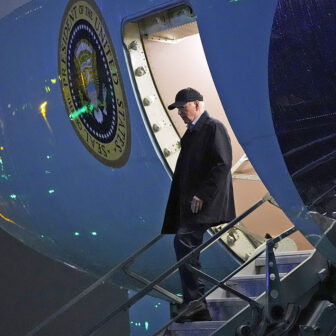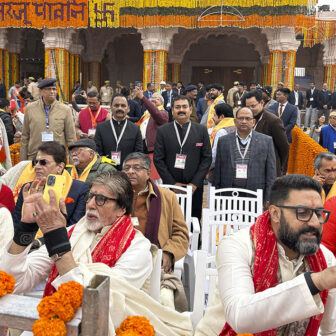Photos by David Corlett unless indicated
In January this year the government that defeated the Tamil Tigers after thirty years of bitter civil war, and then entrenched itself through fear and corruption, was ambushed at the ballot box. Less than six years after president Mahinda Rajapaksa announced the defeat of the Liberation Tigers of Tamil Eelam, or LTTE, the seemingly secure leader was vanquished.
During the five months since then, the story behind Sri Lanka’s peaceful revolution has begun to emerge. It is a chronicle of uncomfortable alliances, secret meetings and clandestine campaigning that brought together an unlikely grouping from across Sri Lanka’s political spectrum. And the story is still unfolding as the country heads towards its next parliamentary elections, likely to be held later this year.
Among the participants in the creation of this election-winning coalition was Sarath Fonseka, who is widely credited with being the real leader of the successful offensive that brought the war with the Tamil Tigers to an end in 2009. Fonseka was Rajapaksa’s chief of army at the time, but split with his boss a year later because, he told me, he began noticing a tendency to authoritarianism. He is now a field marshal in the Sri Lankan army.
“Rajapaksa’s conduct was not acceptable to this country, especially after we finished the war,” Fonseka said when we met at his office near Sri Lanka’s parliament building in Colombo. “He and his brother” – defence secretary Gotabhaya Rajapaksa – “his whole family, his children, his wife, everybody was trying to behave like a king here. They were behaving like dictators.”
In the words of Ruki Fernando, an adviser to the Inform human rights documentation centre in Colombo, the Rajapaksa family had “captured” the whole Sri Lankan state. “They’d captured the judiciary, they’d captured the media, they’d captured the legislature by installing one of the president’s own brothers as a speaker and buying over many other members of parliament,” he told me. “They’d captured religious leaders, including Buddhist as well as significant and prominent Christian leaders. So in many dimensions, it was a whole capture of the state. Sri Lanka was already under the spell of an unofficial dictatorship or, I could say, an elected dictatorship.”
Symbolic of the Rajapaksa rule were the dreaded white vans, in which victims were abducted and taken to secret locations, where they were tortured, raped and often killed. With such a grip, how were the Rajapaksas defeated? According to senior lawyer J.C. Weliamuna, a participant in the plan to break their hold on power, “The change germinated with the ordinary person’s demand to re-establish democracy.”
Not surprisingly, ordinary Tamils had been fearful of the Rajapaksa government for a long time. The war had ended, but its legacy remained, and war crimes allegations remained unresolved. Thousands of “disappeared” people were unaccounted for, and tens of thousands of others remained displaced, their land confiscated by the military. And the ongoing military presence in the north and east, along with claims of continued military abuses, remained a cause of discontent. Muslims, the other significant minority in Sri Lanka, saw the Rajapaksa regime as increasingly hostile, especially given its support for the anti-Islam, Buddhist-nationalist Bodu Bala Sena movement.
The fact that members of these minorities decided to vote in January was significant. At the last election before the war ended, in 2005, Tamils in the north boycotted or were forced not to vote by the LTTE. The consequences for the LTTE were disastrous; by contributing to Mahinda Rajapaksa’s winning the presidency, it helped seal the organisation’s fate.
Things were different a decade later. The minority communities were “fed up,” according to Jesuit priest and lawyer Veerasan Yogeswaran, who runs the Centre for Promotion and Protection of Human Rights in the eastern city of Trincomalee. “They were expecting a change. This is the only way they can show the change – by voting. So before the political leadership took any decision the people were decided. They wanted the Mahinda Rajapaksa government to be out. Therefore the minorities decided to take part in the voting.”
But the minorities alone could never defeat Rajapaksa and his allies. What ultimately led to his downfall was the erosion of the wide support he’d once enjoyed. “The vast majority of the population, which is Sinhalese Buddhist, has been very supportive of the Rajapaksa rule, particularly in relation to the ending of the war,” said Inform’s Ruki Fernando. “So there was not much outrage against abuses committed during the last phases of the war and against minorities in general. But when the majority of the population felt this dimension of state capture, the level of family rule and the power and the wealth that the Rajapaksa family was getting for themselves, I think they did feel outrage, they did feel that is unacceptable.”
But while the alienation was growing, it was also disorganised and fearful. Few ordinary Sri Lankans were brave or reckless enough to stand up to the regime. Slowly, civil society started to organise.
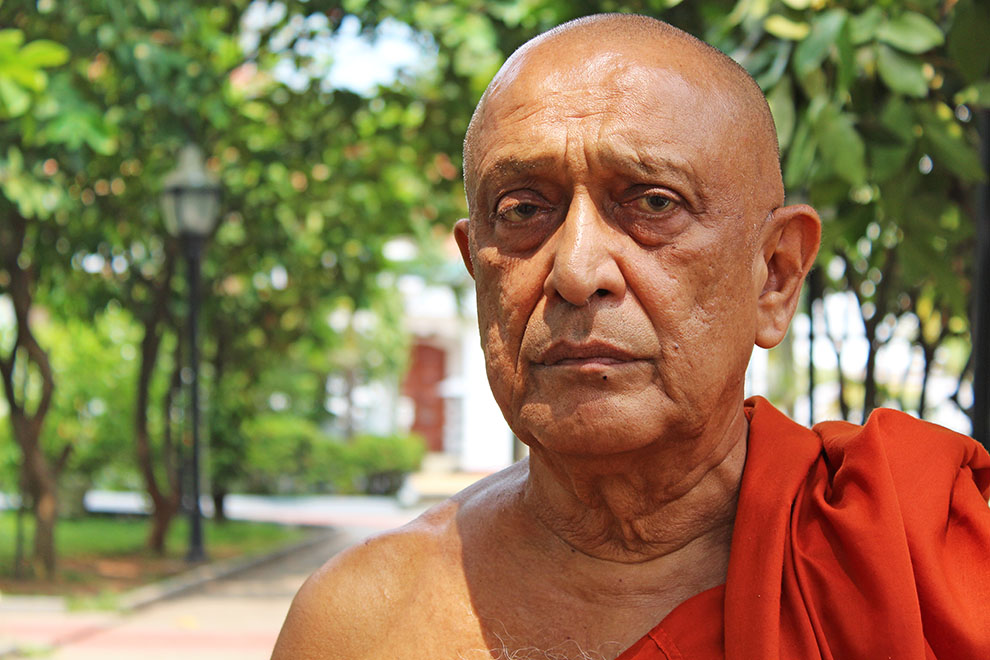
Maduluwawe Sobitha, a senior Buddhist monk, played a vital role.
“About a year and a half or two years ago, there were a couple of movements in the country,” J.C. Weliamuna told me. “There was one movement of lawyers that took on the government over the wrongful impeachment of the chief justice.” The Rajapaksa-dominated Sri Lankan parliament voted in January 2013 to remove chief justice Shirani Bandaranayake when she was accused of corruption after a series of decisions that annoyed the government. “That probably was the first challenge of the government’s political decisions.” But Weliamuna and others also point to a movement created by a senior Buddhist monk, Venerable Maduluwawe Sobitha, as vital to the evolution of the anti-government forces.
“The executive presidency of the country had an unreasonable, excessive authority,” Sobitha told me when we talked in his office at the Kotte Naga Vihara temple in Colombo. He was wearing the saffron-coloured robe that identifies him as a monk. “The whole country was under the president’s rule. People were scared to talk about this. Therefore, I decided that I would come out and make a voice. I had a feeling that if I came forward with my voice, there would be others who would follow me.”
Sobitha established the National Movement for Social Justice, which worked on the basis that “if we want to have a just society or a good governance, the constitution has to be changed and the executive president should be subject to the laws of the country.”
But the growing public alienation and the emerging civil society movement against Rajapaksa still needed added political clout. “Slowly we were working with the political parties behind closed doors,” said Weliamuna, who was on the steering committee of the National Movement for Social Justice. “This included the main Tamil Party, the Tamil National Alliance, as well as the opposition United National Party.” These dissenters found they had allies even within the government, “but they were dead scared. Those people didn’t know if they would be killed or abducted.”
This climate of fear hung over the planning to overthrow Rajapaksa. Meetings were held in secret and “in odd places,” Weliamuna said, because the organisers were being followed. Discussions with the man who eventually became president, Maithripala Sirisena, often occurred through intermediaries because the Rajapaksa security apparatus was monitoring him. When he did attend meetings in person, Sirisena sometimes came in disguise.
Even Sobitha, the respected monk, was subjected to intimidation, with the feared Criminal Investigation Department monitoring his movements. He said that he was sent threatening messages and his telephone was tapped. Sobitha’s secretary told me he would come to the monastery late at night or early in the morning to meet in person with Sobitha, and they avoided speaking on the phone.
By this time, a number of Sri Lanka’s political heavyweights, including people who were once fierce enemies, had become involved in planning for the election. Former president Chandrika Kumaratunga and Ranil Wickremesinghe, the leader of the United National Party, were “the architects” of the “rainbow coalition” that would eventually win the election, according to Weliamuna.
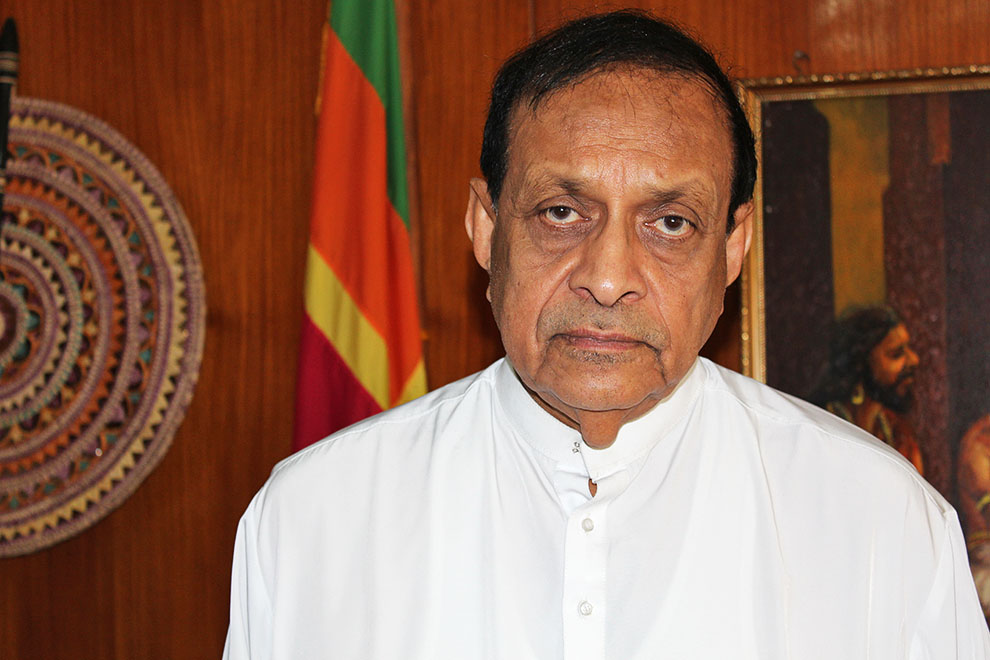
Public administration and democratic governance minister Karu Jayasuriya insists that the mood of the people was clearly for change.
“Within this coalition there were political parties with divergent views and yet we were able to agree on one condition, abolition of the executive presidency,” said Karu Jayasuriya, a former Rajapaksa minister who is now Sri Lanka’s public administration and democratic governance minister. What was needed now was a presidential candidate who could challenge the popularity Rajapaksa continued to enjoy among sections of Sri Lankan society.
As leader of the opposition United National Party, Ranil Wickremesinghe was the obvious choice. He had been prime minister twice before, though – including during Kumaratunga’s presidency – and it was felt he had little chance of persuading Rajapaksa supporters to change sides.
“The common candidate must be acceptable to the south as well as the north. They must be acceptable to Sinhalese, to the United National Party, the government party that has forty per cent of the vote, the left, the right,” J.C. Weliamuna told me. “It ultimately came down to four people. Sobitha declined immediately. Then came Ranil Wickremesinghe. And he was quite open. He showed immense maturity to step aside for a winning candidate.”
Next came former president Kumaratunga. “Chandrika was wavering. She was not sure that the United National Party would support her. But she was also acceptable. And she also showed immense maturity in putting the things together.”
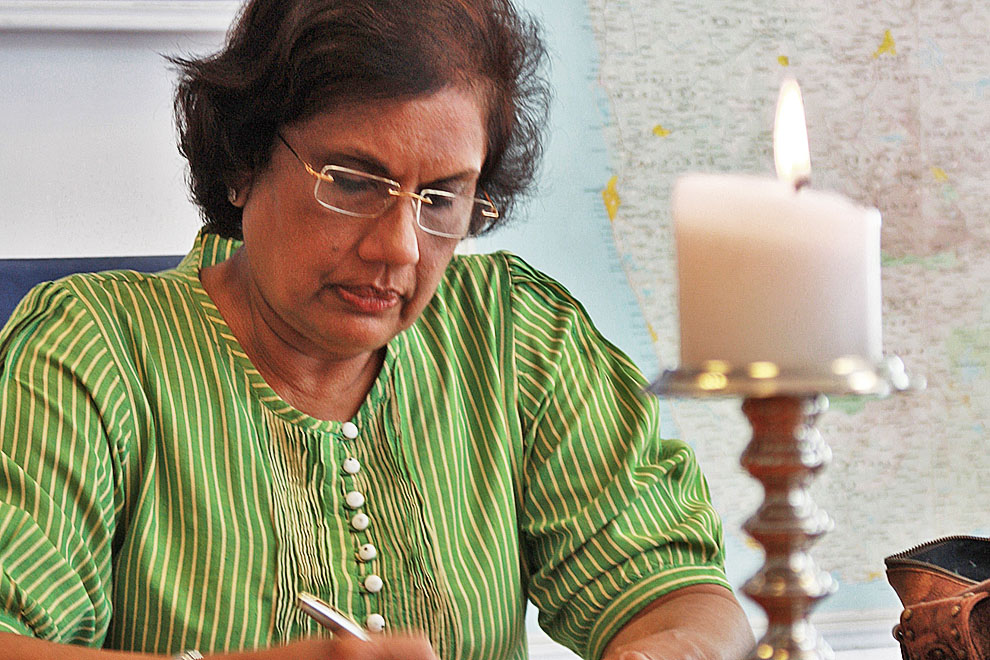
Former president Chandrika Kumaratunga was one of three leaders involved in making “strategic, quick decisions.” Jon Otto Brødholt/ Utenriksdepartementet UD
That left Maithripala Sirisena, who had “been in dialogue behind closed doors for about six months then.” Sirisena was health minister at the time, and general secretary of Rajapaksa’s party, the Sri Lanka Freedom Party.
According to Field Marshal Fonseka, the eventual decision to go with Sirisena required everyone’s agreement. Fonseka insists that he was one of the figures involved at that point. But another source, who preferred not to be named, told me it was Kumaratunga who, at least in the first instance, called the shots. The source said that she summoned both Sirisena and Wickremesinghe, separately, to secret meetings in Singapore. Her aim was to encourage the former to stand against his feared boss and the latter to set aside his ambition to be president for the sake of a winnable unity candidate.
“There was an understanding that the political decisions must be taken at the top level,” he said. “The top level included all the leadership. The strategic, quick decisions were taken by Chandrika [Kumaratunga], Ranil [Wickremesinghe] and Maithripala [Sirisena].” It all happened in secret, and the final decision was not made, according to minister Karu Jayasuriya, until the very final days before the presidential election was announced.
On 20 November last year, eighteen months earlier than necessary, Mahinda Rajapaksa called the election on the advice of his fortune-teller. If he had won, it would have been his third term, a feat only possible after his party legislated to change the constitution.
The evening before the formal election announcement, Rajapaksa met with Sirisena in the latter’s capacity as general secretary of the president’s party. Sirisena said nothing that night about his intention to stand; it was only the following day that his candidacy on behalf of the rainbow coalition was announced.
But not all the surprises came from the new opposition grouping. At the last moment, Rajapaksa had found out about the plot to overthrow him. On the day before his election announcement, according to Weliamuna, the coalition was expecting that thirty-one parliamentarians would come across to the new grouping with Sirisena. But on the following day it became clear that a number of them had got cold feet. Others, according to Weliamuna, were bribed. Only eight joined the challenger.
The Rajapaksas harnessed “the entire state apparatus” for the election, said Weliamuna. “State resources were blatantly used for political propaganda. All the state institutions became party offices, and Rajapaksa’s senior level of politicians, the police, military, they were all used for election purposes.”
Public administration minister Karu Jayasuriya agrees that the campaign was fundamentally unfair. “The government broke all the rules, all the norms of democracy. All was abused. State media was not only abused, but also used to propagate against us, creating lies.”
“Everybody was in fear,” said a former senior official on Sirisena’s campaign staff. “We had to change cars and go… because we don’t know from where the gunman come on the motorbike.” The former official asked not to be named because of fears the former president may re-emerge in the parliamentary elections likely in coming months.
“You don’t know what tricks we did,” the former official added. “And what risks we took to go ahead with this campaign.” The Sirisena team couldn’t get its campaign posters out to the country, for example, because “anybody gets caught with our posters in a vehicle he won’t be released until the elections are over.” So they contacted the head of the private bus owners’ association, who agreed to transport the posters secretly under the back seats of their night buses.
“Only one place we got caught,” the former official said. “When they were unloading the posters at Kegalle, one opposition fellow saw this and he noted down the number of the bus. Like lightning, they just vanished with the posters. Then they were waiting till the bus comes back, to set fire to the bus. So we got that information and gave a call to the president [of the private bus company] and told him to get [the driver] to change the number plate of the bus. With that only, he escaped.”
Notwithstanding the difficulties, momentum built. The parties representing Sri Lanka’s minorities – the Sri Lanka Muslim Congress and the Tamil National Alliance – had detected the changed mood within their constituencies. In late December, the Muslim Congress formally defected from the government and aligned itself with the rainbow coalition’s “common candidate.” A couple of days later, the Tamil National Alliance also endorsed Sirisena.
Inform’s Ruki Fernando said that bringing down the Rajapaksas required an astonishing degree of compromise. “Many people felt uncomfortable with each other within the political coalition that defeated the Rajapaksas. But although it was a very uneasy, uncomfortable alliance, the dangerous enemy and the power of the dangerous enemy, and the importance of chasing away that dangerous enemy brought people together.”
Part of the compromise was to agree to play down potential differences. “The parties agreed what to raise and what not to raise on the election campaign,” said J.C. Weliamuna. “And everybody agreed that the primary concern was President Rajapaksa, that the focus will be to defeat Rajapaksa.” Each of the parties had to sacrifice positions that were important to them. “All the parties agreed that they would not raise the national ethnic issue in the campaign. Because that would be useless. Devolution [of power from the central government to the minorities living in the north and east] would not be raised.”
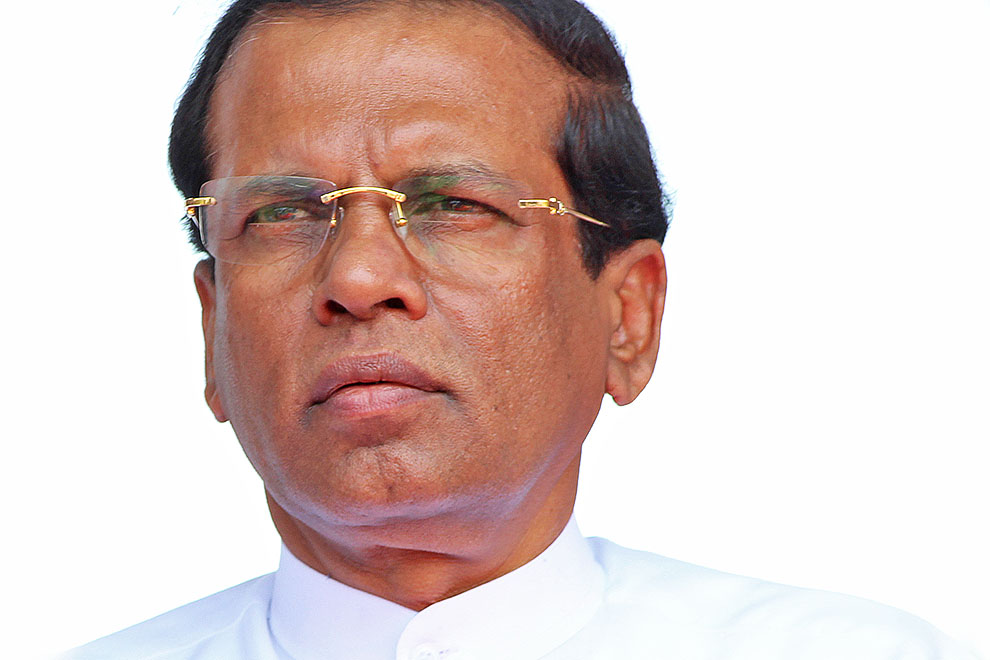
The final decision for Maithripala Sirisena to run as presidential candidate was made only days before the election was announced.
This strategy was designed to undermine Rajapaksa’s efforts to capitalise on his status as the president who defeated the LTTE and his attempts to convince voters that the opposition would divide the country. “The team of Rajapaksa wanted to say that Maithripala Sirisena, Ranil Wickremesinghe and Chandrika Bandaranaike will divide the country,” according to Field Marshal Fonseka. “That was their main trump card.”
The argument was undermined not least because Fonseka himself, the general who won the war, had sided with the president’s opponents.
The coalition also had the power of committed people. “There was no media, there was no money, there was no power,” Weliamuna said. “We kept on telling the people that they are more strong, more powerful than anyone else.”
“Election day was a nightmare,” recalled Weliamuna. Faced with a surging opposition, Mahinda Rajapaksa placed enormous pressure on the electoral apparatus, and the man in the middle was election commissioner Mahinda Deshapriya.
Representing the opposition, Kumaratunga, Wickremesinghe, Sirisena, Wijeyadasa Rajapakse (Sirisena’s election agent) and Weliamuna had met with Deshapriya for an hour and a half before the election. They presented the commissioner with “all the communications that the military has made on the elections, virtually suggesting that the military will get involved in the elections,” according to Weliamuna. “And we leaked out information from the military, including intelligence reports, and placed it before the election commissioner.”
These included documents marked “Top Secret” that ordered the military to assist the police “by undertaking certain responsibilities… during the presidential election” and “in the event of an unforeseen situation/requirement during the run up to and the aftermath of the election.” The election commissioner had not been consulted about, let alone approved, these commands.
“When everything was there the election commissioner said, ‘I will do something,’ and immediately he summoned the army commander. They dragged their feet, but they knew that their plans were out,” Weliamuna told me.
In Jaffna district, according to Weliamuna, “the military was basically getting involved and blocking the Tamil vote.” So, at the election commission’s insistence, the police “wouldn’t allow them to get out of the barracks. Amazing things happened that day. In certain counting centres there were plans to disturb the counting; again, the police didn’t allow them to get anywhere near the counting centres. They were just physically [prevented].”
Election commissioner Deshapriya also took control of conveying election results to the public as they became available. (Previously, results were announced from the prime minister’s residence.) By doing this, the commissioner prevented the government from controlling not only the count, but also the flow of information about the count. According to minister Jayasuriya, this had an important bearing on the final outcome because “when they tried to postpone the results, or stop counting, by that time, the results were known to the outside world.”
Hanging over all of this was Rajapaksa’s final fallback: the military option. “We saw troop movements, we saw the statements made by those high up in the then government, saying they would never hand over power, and we also had reports coming from their own side about a few attempts to suppress the results,” Jayasuriya told me in his ministerial office in Colombo. “They believed that they have come to stay and not to go. So there were attempts to stay in power.”
Documents intended to be seen only by seven top officials, including the secretary to the president and the heads of the army, the navy and the airforce, give details of troop numbers and commanding officers around Colombo and throughout the country. Intriguingly, given that in democracies the armed forces should be politically unaligned, the confidential documents also include party polling details within Colombo’s western district.
Field Marshal Fonseka said that the former president’s brother, Gotabaya, hand-picked troops from the battalion in which he had served to come to the capital in case Rajapaksa lost the election. “They thought that they can get them down and they can do some unscrupulous things on the election night in case they were going to lose the election,” he said. “They definitely had the plan to hang on.”
According to Weliamuna, having Fonseka on side attracted many within the military who might otherwise have sided with the government at this crucial moment.
“I gave advice to all the police and the military, all the troops, during my speeches, I told them that you should never get involved in any irregular things, don’t do any wrong things, don’t go against the democratic process or the law and order of the country,” Fonseka told me.
Importantly, these senior officials appear to have picked up on the mood of the public. They understood the potential for what Inform’s Ruki Fernando calls “Sri Lanka’s Arab Spring.” Jayasuriya insists the mood of the people was clearly for change. “If they went against the people’s will, then the people will come out because that mood was very, very strong. They wanted a change. And they didn’t want to allow anyone to hoodwink them.”
If the mood for change was clear, so was people’s preparedness to risk their lives. “People kept asking, ‘Okay, if you win, will the military take over?’” Weliamuna said. “The message from the opposition was very clear. It said that we will be on the streets until everyone is killed or until the military goes. We were prepared to die. We knew that if Rajapaksa came we would be six feet under. We realised that we had to do this.”
Sri Lankans’ enthusiasm for the election was demonstrated by the fact that a record number of voters – more than 80 per cent of those eligible – voted. Nationally, Sirisena won just over 51 per cent of the vote to Rajapaksa’s 48 per cent. But in the north and east, Sirisena dominated, winning all districts with considerable majorities.
Shortly after the election, Mangala Samaraweera, Sri Lanka’s current foreign affairs minister, announced that the Rajapaksas had attempted a coup. Rajapaksa denied the allegations and countered by blaming foreign powers for his electoral defeat. Media reports claimed that India in particular had worked with the Sirisena camp. Those intimately involved in the rainbow coalition say that while many countries took a keen interest in developments, they did not conspire against the former president. As Karu Jayasuriya said, “Of course they are interested, but they haven’t been involved in any way.”
According to lawyer J.C. Weliamuna, “All the intelligence services in the world would be interested. The whole world was watching. That doesn’t mean that all this intelligence was used. Maybe they would have been interested, but the political push and this leadership was indeed the significant factor.”
Rather than being the victim of a foreign conspiracy, Rajapaksa is responsible, Sobitha insists, for his own undoing. “He had two more years to stay in power,” the monk told me. “He had a two-thirds majority [in parliament] at that time and he had all the powers within the provincial councils. My question is: Why did he go to election like this in spite of having all these powers? He is responsible for his own defeat. The election was not in India or in Europe. It happened here.”
Weliamuna said that the foreign connections were especially important on election day, where, with the threat of a military coup imminent, the rainbow coalition leadership kept the international community informed through various consular channels.
Then came the job of governing. The new government had promised major changes within one hundred days, including the abolition of the executive presidency and greater accountability to the parliament, and it was this undertaking that convinced the UN Human Rights Council to delay the release of its report on humanitarian crimes during the civil war.
Despite ongoing calls for Sri Lanka to participate in a full international investigation into wartime human rights violations, though, Sirisena followed his predecessor in promising only a domestic inquiry. It is scheduled to begin this month. While there have been some positive developments in public accountability, including a watered-down reform package passed in April by the Sri Lankan parliament, concerns about human rights remain.
According to the bishop of Mannar, Rayappu Joseph, “The people who were causing the fear in the minds of the people before this government came, they are [still] here. That is the CID” – the Criminal Investigation Division – “and the army and all the other security forces. They are so well armed and they are going about watching what is happening, who is talking to whom. The people are living in fear. Again they are living in fear.”
In the east, Veerasan Yogeswaran, the Jesuit priest and lawyer who supports the families of people who disappeared during the civil war, said that intimidation by security forces continues. “That’s why the north and east are calling to demilitarise these areas,” he said. “Remove excessive army camps and remove armed forces’ influence over civilian life. The government is still not addressing these issues. We are living in an occupied land under intimidation and threat.”
The new government is treading a delicate path. Having set aside its differences to oust the Rajapaksas and curb the executive president’s powers, the “rainbow coalition” is now confronted with the difficult task of meeting at least some of the aspirations of the minorities whose support helped deliver it power, while ensuring that the new government remains electorally palatable to the majority Sinhalese in the south.
“From the dimension of the rule of law and democratic governance, there is very clear evidence that we have already shifted away from that very dangerous authoritarianism,” Inform’s Ruki Fernando told me. “The challenges lie in dealing with the issues related to the minorities, particularly the Tamils and the ethnic conflict. That involves dealing with the root causes of the conflict.”
Fernando believes that this is “essentially an interim government.” He detects “great fear that if it goes too far in reforms in terms of human rights, the Rajapaksas may come back in some form or another, supported by very strong Sinhalese Buddhist nationalists. So that is why there is a tendency for this government to be cautious.”
Indeed, Mahinda Rajapaksa remains a political force in the south, where he is positioning himself to run for prime minister on a wave of Sinhalese nationalism in upcoming parliamentary elections, despite serious allegations of corruption against him and his family.
The government’s caution in seeking a solution to the question of the minorities is “very unfortunate,” according to Fernando. “For example, that is essentially telling the family of a disappeared person, the mother of a son who disappeared, ‘We can’t do anything about your son right now, because if we do, it might cost us politically. It might break up our political coalition, so your wait in finding your son is secondary right now.’ It’s the same issue with land. So they have to proceed very carefully.” •
